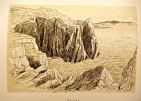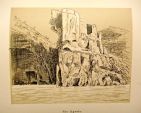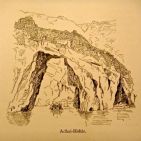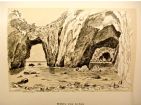
From Trepitos to Achai cave

Then comes another point called Nisaki ( Tis Cambanes) with a rock that moves with strong winds and a tooth-shaped point which has a small bay behind with sloped walls. A bit further we come to Sto Agerla.

Then comes the loose group of Achai reefs, consisting of three primary groups, with a spring underneath a small cave. To the left is an opening which joins a cave with the main one on the side and which is covered in a silvery shine where the sea enters through the broad main entrance. It is one of the most beautiful caves in the Mediterranean, and, along with Trepitos and Ortholithon, one of the island’s three biggest miracles. From the pebbly beach in front of the first cave is one of the prettiest views because you can see both entrances.”


























